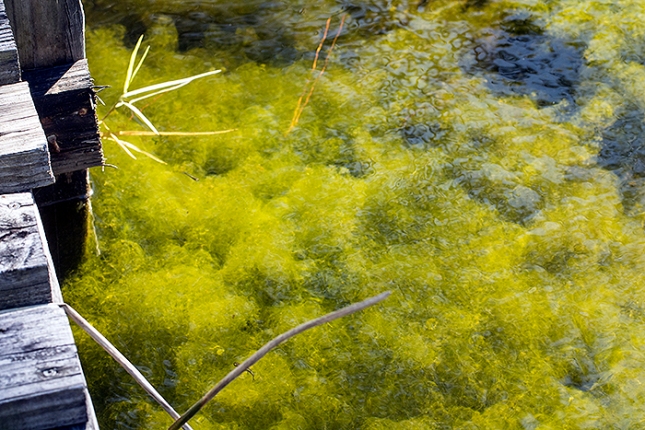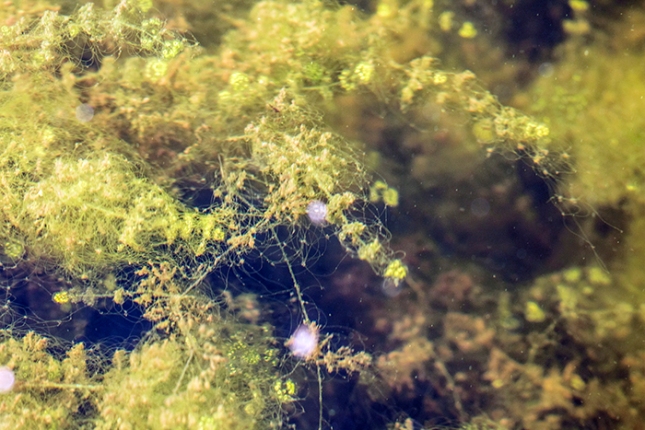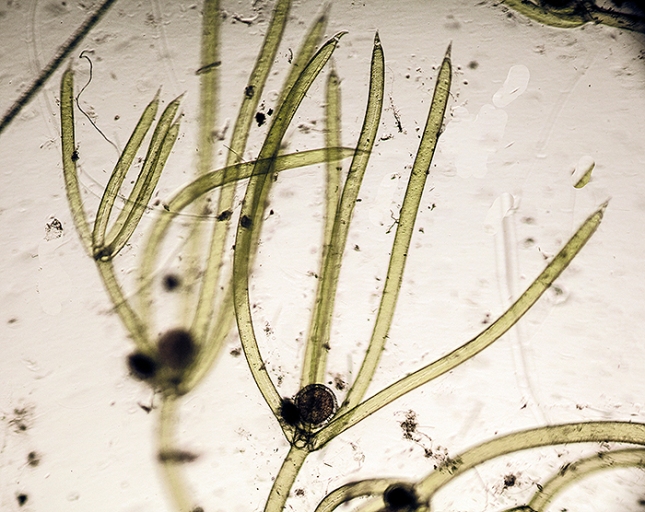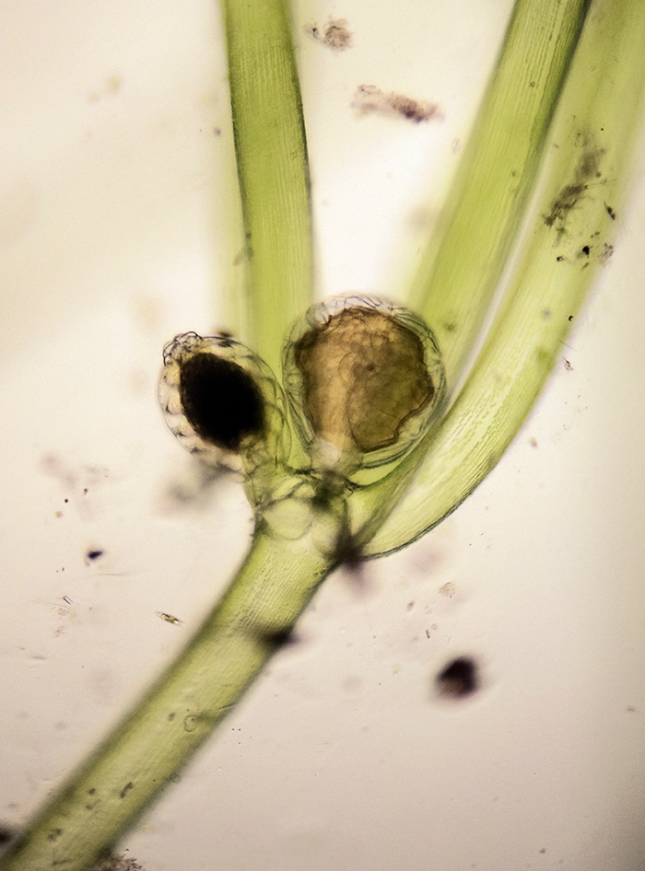Characeae (A family of algae)

Halpatioke Park, a lake. What lurks below?
John and I have been enjoying Halpatioke Park near Stuart, Florida, getting ready for a group field trip in January, and possibly my Palm Beach State College native plants class. Wonderful how many habitats can mosaic just one park, from marshes to riverbank, pinewoods, scrub, and more. Sparkling lakes are embedded in the forest, postcard pretty, feeling remote like a vacation destination. Some have a surprising resident… in billowing green overwhelming masses…Nitella Algae.

Plenty of Nitella.
Most of us see algae as green pond scum, never giving it much thought except in the fish tank, or as biofuel, or as a dietary supplement, or tangling fishooks. But this alga and its similar cousin Chara are old players in the history of botany. They are branched, like a “normal” plant, and have complex reproductive organs that look, without delving into cellular details, like something you’d expect on a land plant rather than on a pond scum.

Nitella mass in the lake,.
Aha! You figured it out already: land plants evolved from Green Algae. Land plants have stems and branches. So does Nitella. Land plants have complex reproductive structures. So does Nitella.
(All true of Chara as well. Chara differs by being stiffer, by having a rough stem, and by a characteristic stink.)

Branches, as seen under a microscope.
When I was a student, textbooks suspected Nitella and Chara or more precisely their closely related predecessors to be ancestors to the land plants roughly 500 million years ago. The ostensible ancestorship has been an area of speculation for years, and then came DNA analysis to spoil the fun. Apparently Nitella and Chara lose their ancestral status.
Similar branchy structures with threadlike stems or leaf segments occur in several unrelated aquatic plants. Such architecture helps keep any shallow plant attached to the mud, wafting in the waves, exchanging gases, and taking in the sun. The earliest land plants, by contrast, were probably not branchy, but rather sprawled on the wet mud.
Very oddly for Green Algae, Nitella and Chara make sperms and eggs inside protective sacs, as do unrelated marine algae. The sperm and egg sacs are not clues to evolutionary ancestry, but rather mere demonstrations that protecting the family jewels matters when you’re near shore battered by waves and surviving fluctuating water levels.

Egg making sac on the left. Sperm-making organ on the right.
In short, Nitella is adapted to occupy shallow lake shores, but why so much of it in the Halpatioke lakes!? Are great green clouds of Nitella natural? Maybe not. One ecological study showed nutrient pollution to spur Nitella growth, at least temporarily, while suppressing its sexual reproduction. Most lakes in South Florida have nutrient pollution, even nice secluded ones in Halpatioke Park, given pastureland all around, the adjacent St. Lucie River, fertilizer nutrients in the rain and groundwater.
And to end a little ironically, the very weed killer spewed on an industrial scale to suppress unwanted plant life may contribute to the overgrowth in aquatic habitats. Glyphosate, aka Round-Up, herbicide is a source of aquatic phosphorus pollution. It can fertilize the enemy.
theshrubqueen
January 6, 2018 at 10:57 am
George, thanks for a great post. Will the evils wrought by round up ever end?
FlowerAlley
January 6, 2018 at 1:13 pm
Very interesting. Great photos and information. Thanks
Gabriela Quintanar
January 22, 2018 at 10:28 am
It is very interesting to learn that Nitella is related to the Green Algae. I am currently taking your Botany Class and it will be a great idea to plan a trip to Halpatioke Park to learn more about Nitella. Very thoughtful post😊.
George Rogers
January 22, 2018 at 10:35 am
Gabriela, I’m trying to get some growing in the classroom fish tank, and would love to take a botany class field trip…to Halpatioke. I wonder if that is somehow possible…I’ll check on liability etc.
Areli Resendiz
January 22, 2018 at 12:57 pm
Going to a national park to explore different natural habitats and be able to learn about Nitella is a great idea. It gives students the opportunity to be able to see it with their own eyes.